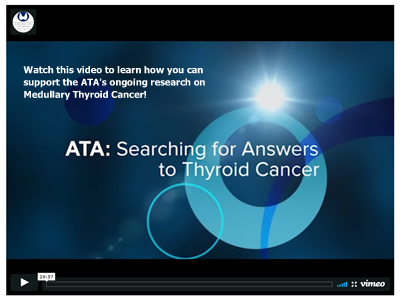Clinical Thyroidology for the Public summarizes selected research studies discussed in the previous month’s issue of Clinical Thyroidology, an official publication of the American Thyroid Association. Editor-in-chief, Alan Farwell, MD, FACE
Volume 10 Issue 12
Available in pdf format for saving and printing and Web page format for viewing online
PDF Format for Saving and Printing
Clinical Thyroidology for the Public Volume 10 Issue 12 (PDF file, 10.8 MB)
TABLE OF CONTENTS – Web Format
THYROID CANCER Is it appropriate to refer to thyroid cancer as the “good cancer” in discussions with patients with thyroid cancer?
Because there are effective treatments for most forms of thyroid cancer leading to an overall excellent prognosis, some providers to refer to thyroid cancer as the “good cancer” to their patients. However, there is increasing awareness that patients and physicians often differ in how they perceive the seriousness and consequences of a particular illness. The goal of this study was to determine the reaction of selected patients with thyroid cancer to perceptions of their illness as conveyed to them by health care providers, their family members, and their support network.
Randle RW, et al Papillary thyroid cancer: the good and bad of the “good cancer.” Thyroid 2017;27:902-7. Epub June 12, 2017.
(PDF File for saving and printing, 661 KB)
THYROID AND PREGNANCY Hypothyroid symptoms in pregnant women fail to predict hypothyroid status
Women with untreated hypothyroidism during pregnancy are at risk of having a miscarriage and complications such as premature birth and low birth weight babies. However, universal screening for hypothyroidism is very controversial and most guidelines support an approach of case-finding to test only those women who are truly at risk of hypothyroidism, such as those with symptoms. The following study was designed to determine the association between TSH levels and symptoms of hypothyroidism in women during early pregnancy.
Pop VJ et al. Thyroid disease symptoms during early pregnancy do not identify women with thyroid hypofunction that should be treated. Clin Endocrinol (Oxf ). July 26, 2017 [Epub ahead of print].
(PDF File for saving and printing, 832 KB)
THYROID AND PREGNANCY Thyroid hormone levels during pregnancy may be associated with premature delivery
Prematurity is one of the most important causes of death in newborns and babies. Research has shown that both hyperthyroidism and hypothyroidism are associated with poor outcomes for the mother and the developing newborn, including premature delivery. This study aimed to determine whether mild variations of thyroid function during pregnancy are associated with preterm delivery in women without thyroid disease.
Johns LE et al. Longitudinal profiles of thyroid hormone parameters in pregnancy and associations with preterm birth. PLoS One 2017;12: e0169542.
(PDF File for saving and printing, 657 KB)
THYROID NODULES Large study confirms the 2015 American Thyroid Association guidelines for classifying small thyroid nodules on ultrasound
While thyroid nodules are a common medical problem, 90-95% of nodules are benign. Given the high frequency of thyroid nodules with a low risk of cancer, it is important to rank thyroid nodules based on their risk of being a cancer to detect thyroid cancer and avoid unnecessary biopsy in benign nodules. The 2015 ATA guidelines suggest ranking the cancerous potential of thyroid nodules based on their ultrasound appearance. The goal of this study was to validate ATA risk ranking system for thyroid nodules measuring 1 to 2 cm.
Lee JH et al. Validation of the modified 4-tiered categorization system through comparison with the 5-tiered categorization system of the 2015 American Thyroid Association guidelines for classifying small thyroid nodules on ultrasound. Head Neck. 2017 Nov;39(11):2208-2215.
(PDF File for saving and printing, 742 KB)
THYROID CANCER The role of ultrasound in predicting thyroid cancer invasiveness
Follicular variant of papillary thyroid carcinoma (FVPTC) is one of the subtypes of papillary thyroid carcinoma, which has been classified to three different forms that vary on their aggressiveness. In this study the authors reviewed the thyroid ultrasound images that were obtained before thyroid surgery in patients with different types of FVPTC. The goal was to identify certain ultrasound characteristics specific to each subtype of FVPTC, which could potentially predict the type and thus invasiveness of FVPTC before thyroid surgery.
Hahn SY et al. Role of Ultrasound in Predicting Tumor Invasiveness in Follicular Variant of Papillary Thyroid Carcinoma. Thyroid 2017; 27: 1177-84.
(PDF File for saving and printing, 719 KB)





